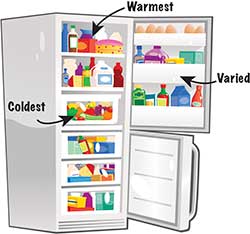Storage
Get the Most From Your Fridge
The fridge is one of the most important tools you have in fighting food waste. It’s something we use so often we rarely think about how it works best. Here are some tips to help you, help your fridge!
First of all, make sure the temperatures are correct. The temperature of your fridge should be between 0-5°C, ideally 4°C.

Top Shelf – This is the warmest part of the fridge and best for ready to eat foods like yoghurt, cheese and sauces. Cooked meats and leftovers should be stored in sealed containers on the shelves underneath. If there’s space, keep milk here too – it’ll keep for longer than it would in the door rack where it’s warmed by warm air whenever the door is opened.
Bottom shelf – As this is the coldest part of the fridge, keep raw meat, fish and poultry here. These should be stored in their sealed packaging or in sealed containers. Keeping these here also means there is less chance of their juices dripping and contaminating the whole fridge.
Bottom drawers – These are for fruit and veg and are designed to keep them crisper. Some come with humidity controls to retain moisture which will help certain vegetables last longer. Remember, certain fruits should be kept out of here.
Door racks – Because the temperature in these can vary a lot each time the door is opened. It is a good place for eggs, condiments, jam and fruit juice. A lidded compartment is ideal for eggs and butter.
Store strategically – we often use whatever containers are in our kitchen to store food in our fridge. Different sized containers can mean a lot of wasted space. Use consistent containers and stack bags of food.
Keep ‘er full – a full fridge and freezer works more efficiently. When you open the door of your fridge, the cold air flows out and is replaced by warm air. The more space in your fridge, the more air that is swapped every time the door opens. This works great until a certain point. A jam-packed fridge stops air circulating and puts extra pressure on your motor.
Other tips
In general, food with a Use by Date should be kept in the fridge. If you are using this food then try and put it back in the fridge as quickly as you can after using it. As the saying goes ‘milk left out for an hour is the same as a day in the fridge!’
Bread shouldn’t be stored in the fridge – it will actually speed up the staling process.
Make sure your fridge is maintained properly – this will ensure food is cooled properly and saves on electricity costs too. If there is frost build up in the back of your fridge there are a number of different things that could be wrong (drain hole blocked, door seals broken, low refrigerant gas) but it is best to get it checked straight away.
When sourcing storage containers for leftovers, look for clear containers so that you can see what’s in them. Easy! If you can see what’s in the fridge from one glance, you are less likely to overlook something tasty before it goes off. Bear in mind that square and rectangular containers will stack and fit in the fridge better than their round counterparts.

